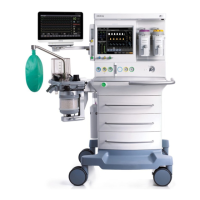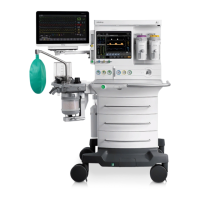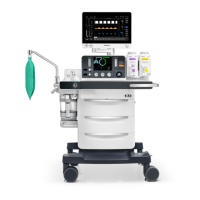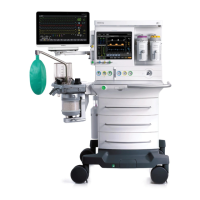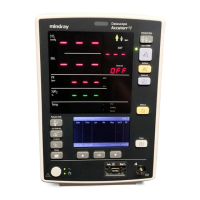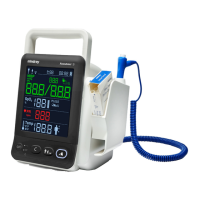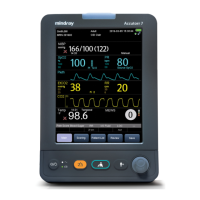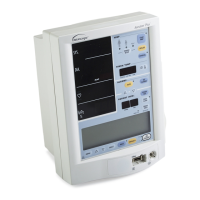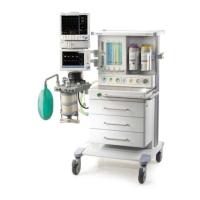5-18
3. Remove the bypass assembly
4. Remove the O2 cell
5. Pull out the Breathing System
6. Verify the alarm message Breathing System Not Mounted appears.
7. Remove the Volume Exchanger
8. Verify the alarm message Volume Exchanger Not Mounted appears.
9. Re-install the Volume exchanger and verify that the Volume Exchanger Not Mounted
message disappears.
10. Install the Breathing System and verify the alarm message Breathing System Not Mounted
disappears.
11. Install the O2 sensor
12. Install the bypass assembly
13. Install the CO2 absorber canister
14. Verify the alarm message CO2 Absorber Canister Not Locked disappears
5.13.3 O2 Supply Failure and Balance Gas Branch Flow Not Achieved
Alarm Tests
Ensure that the O2, AIR, and N2O (optional) supply input pressure is not lower than 300 kPa (44
PSI). Set the ventilation mode to Manual and start ventilation.
Note: If the hospital has no N2O supply, N2O tests can be skipped.
5.13.3.1 O2 Supply Failure Alarm Test
1. Under the BFCS state, adjust the O2 needle valve to ensure that the reading on the total
flowmeter is 1±0.5 L/min.
2. Disconnect the O2 supply. Verify the O2 Supply Failure alarm and Drive Gas Pressure
Low alarm occurs on the anesthesia machine.
3. Re-connect the O2 supply. Verify that the O2 Supply Failure alarm and Drive Gas
Pressure Low alarm disappears.
5.13.3.2 Balance Gas Supply Failure Alarm Test
1. Connect the O2 and N2O supplies and adjust the O2 flow so that the reading on the
flowmeter is 2 L/min. Set the balance gas to N2O, adjust the N2O flow to 5 L/min, and
adjust the N2O supply input pressure. When the pressure drops until the N2O Supply
Failure alarm occurs on the anesthesia machine, verify that the N2O supply input pressure
is 220±34 kPa(32±5 PSI). Gradually increase the N2O supply input. When the N2O
Supply Failure alarm disappears, verify that the gas supply input pressure is 220±34
kPa(32±5 PSI).
2. Connect the O2 and air supplies, set the balance gas to air, and adjust the air flow so that the
reading on the flowmeter is 5 L/min. Adjust the air supply input pressure. When the pressure
drops until the Air Supply Failure alarm occurs on the anesthesia machine, verify that the
air supply input pressure is 220±34 kPa(32±5 PSI). Gradually increase the air supply input.
When the Air Supply Failure alarm disappears, verify that the air supply input pressure is
220±34 kPa(32±5 PSI).

